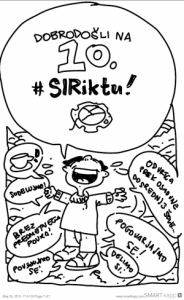Iztok Ostrožnik, Osnovna šola Ivana Kavčiča, Izlake
During the school year 2015/2016 I started using tablet computers with nine graders during maths lessons. My aim was to increase pupils’ motivation and to take advantage of ICT during classes. Pupils use electronic devices every day, mostly for fun. So why not use them for work? At the beginning I did not set any particular goals, I only wanted to check the pupils’ reactions. The rest of the activities were done spontaneously during the school year. I started by using different applications and so my explanations in the classroom became more varied and interesting. I prepared material with which I carried out some lessons. To test the pupils’ knowledge and to deal with new topics, I used e-books, Kliker, Geogebra, Smart tools, Nearpod, QR codes, etc. The pupils soon became familiar with these applications. They preferred Nearpod. So we started making materials mainly for this tool, first myself, then the pupils. The pupils were highly motivated, eager for this type of lessons. The concept of making presentations in Nearpod is simple. The pupils did not require any explanation, they made the presentations at home. Some chose new topics, and some the topics already dealt with. Before the pupils carried out their presentations, I had examined them in case any corrections were needed. Then we switched our roles. The pupils were pleased, active and motivated and in the end they acquired all the required knowledge. In this way, the pupils were a lot more motivated for work. They like electronic devices. They have learnt that they can do something useful with them. They have become more active. By using Nearpod, a teacher can get a real-time feedback on their pupils’ progress. The drawbacks of such lessons are tablet computers themselves. Children already spend too much time with such devices and then they use them at school as well. Such lessons demand a lot more preparation from the teacher. Nearpod itself has got some drawbacks, especially when choosing source material and when examining presentations. All in all, it was a positive experience, one that I hope to repeat or even upgrade next school year as well. We really should take advantage of pupils’ creativity.
